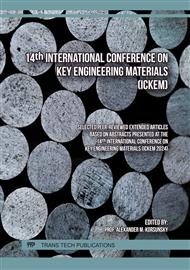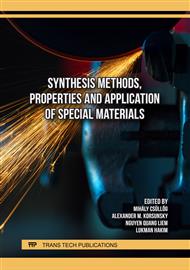p.3
p.13
p.23
p.35
p.43
p.51
p.61
p.71
p.81
Experimental Investigation of the Dynamic Compressive Behavior of Carbon-Flax Fiber Reinforced Polymer Composites at High Strain Rates
Abstract:
The present study investigates the dynamic compressive behavior of hybrid carbon/flax fiber-reinforced polymer composites in which epoxy resin is used as the matrix. The hybrid carbon/flax and non-hybrid flax polymer composite laminates were fabricated by hand lay-up followed by hot-compression molding. The Split-Hopkinson pressure bar test (SHPB) was utilized to evaluate the dynamic compressive mechanical properties of the fabricated composites. Compressive strength and failure strain were determined in the sample’s out-of-plane direction at strain rates ranging from 2638 s-1 to 6716 s-1. Macroscopic images were used to assess the progressive accumulated damage mechanisms due to the impact loading. Experimental results proved that non-hybrid flax and hybrid carbon/flax epoxy composites are high strain-rate-sensitive materials. For instance, the compressive strength of hybrid carbon/flax composites has increased from 327 MPa to 498 MPa as the strain rate increased from the lowest to the highest value in the considered range. At all impact pressures, hybrid carbon/flax composites have shown higher compressive strength than non-hybrid flax composites. The macroscopic inspection of post-tested composite specimens indicated that the accumulated damage becomes more severe with increasing the strain rate; and the main failure modes were shearing and splitting for both hybrid and non-hybrid composites. Overall, carbon/flax hybridization was found to be an effective technique for improving the load-bearing capacity of the polymer composites subjected to impact loading conditions.
Info:
Periodical:
Pages:
43-49
Citation:
Online since:
September 2024
Price:
Сopyright:
© 2024 Trans Tech Publications Ltd. All Rights Reserved
Share:
Citation:



